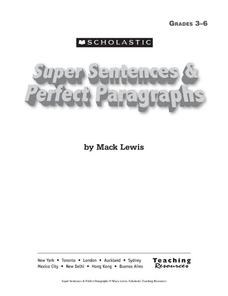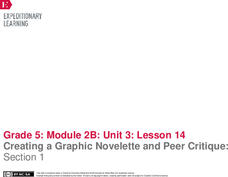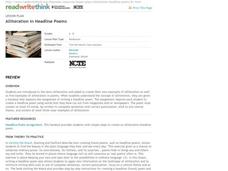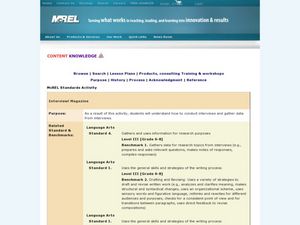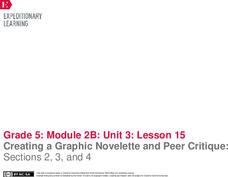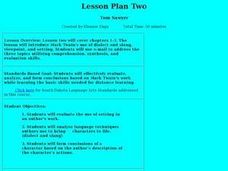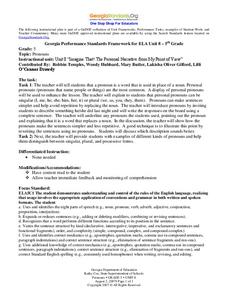Scholastic
Super Sentences & Perfect Paragraphs
An extensive collection of lessons and activities includes many writing, grammar, and proofreading exercises. With templates and worksheets that cover several steps in the writing process, from sentence to paragraph to essay, this...
EngageNY
Storyboard Revision: Managing the Sequence of Events and Using Sensory Details
Mastering techniques from the resource, pupils give life to their writing, revising their storyboards to include sensory details and transitions. To finish, they participate in a peer critique process and use the feedback to further...
Curated OER
The Raven
After a close reading of Edgar Allan Poe's "The Raven" individuals copy the rhythm and rhyme scheme and rewrite the final stanzas of the poem.
Curated OER
Bias
Students apply techniques of distinguishing between fact and opinion. Students identify words associated with persuasion and argument. Students read and categorizer a variety of newspapers and articles. Students identfy bias in a...
Millard South Patriots
Trait Practice: Sentence Fluency
Do your young writers need a little help varying their sentence structure? Have them work on common errors, sentence fluency, and writing patterns with a series of language arts activities. The resource includes reading passages as well...
EngageNY
Creating a Graphic Novelette and Peer Critique: Section 1
Help the class put a plan in place. With the detailed resource, pupils plan the first section of their graphic novelettes about an invention, creating and labeling their pages. Next, they work with partners to give and receive feedback...
ReadWriteThink
Alliteration in Headline Poems
Poetry is everywhere you look! Create found poems using headlines from newspapers and magazines. Young poetry focus on creating alliterative phrases with words they find in headlines, tying their poems to a central theme.
Curated OER
Persuasion
Students read various stories and write reflections in their journals. Using the text, they identify the techniques the characters used in persuading the reader or other characters in the story.They rewrite a fairy tale from the villains...
Curated OER
Mountain Myths
Students become familiar with Native American myths and legends created to explain volcanic activity. They apply the clustering, writing process and peer-editing techniques to the writing of an original myth about Mount St. Helens
Curated OER
Writing Through Reading
Learners are introduced to a new method of writing developed by Robert Gay. In groups, they practice retelling or rewriting one of their fellow classmates stories. They are also introduced to the technique of transcribing and write in...
Curated OER
Monster Voices
Students create stories based upon the techniques of author Maurice Sendak in Where the Wild Things Are. They use a word processing program and the Apple software program GarageBand to create new voices for the story. ...
Curated OER
Health: The Three Dimensions
Students examine the three dimensions of health, wealth, and happiness from both emotional and social perspectives. Among the week-long activities are discussions about good and poor habits, minimizing risks by proper planning and...
Curated OER
Interview! Magazine
Learners interview a subject and write a biographical sketch for a fictional magazine. In this interview lesson, students choose a person to interview and create two sets of questions. Learners conduct the interview. Students then write...
Curated OER
Writing: A Lesson Plan on Beginnings
Learners rewrite the beginning of a story. For this writing lesson, students read stories from Spooky South by S.E. Schlosser in order to gain exposure to different ways to begin a story. Then, learners chose one of the three techniques...
Curated OER
The Chemistry of Water / Industrial Waste at My High School
High schoolers gain factual knowledge of the nature of industrial waste at on their school site. They gain process knowledge of the laboratory techniques and collection procedures for wastewater samples.
EngageNY
Final Performance Task: Presenting Graphic Novelettes
Let's get graphic. Serving as the final performance task of the unit, scholars complete their graphic novelettes and design covers based on their sketches. Finally, they present their hard work to classmates.
EngageNY
Creating a Graphic Novelette and Peer Critique: Sections 2, 3, and 4
Let's get creative! With the fun resource, pupils continue working on their graphic novelettes about an invention, adding text and images to each section. When finished, they engage in a peer critique process, giving and receiving...
Curated OER
Character Development Through Song
Students use songs to analyze their sense of identity and self-worth. In groups, they discuss and explore their own character development and discover how far they have come in recent years. They also identify the positive and negative...
Curated OER
Tom Sawyer
This instructional activity kicks off with a PowerPoint presentation on Mark Twain. Learners examine the dialect, slang, viewpoint and setting. Then use e-mail to address three topics utilizing comprehension, synthesis, and evaluation...
Curated OER
Examining Persuasive Literature
Examine persuasive literature and writing. In this persuasive literature lesson, pupils work through a variety of activities over the course of three weeks (each week is planned by day). The unit's purpose is to examine examples of...
Curated OER
Shoes from Grandpa Lesson Plan
Students read a cumulative text. In this Shoes from Grandpa lesson plan, students examine language usage, different media sources, and literary devices.
Curated OER
Pronouns
Fifth graders study pronouns. In this grammar lesson, 5th graders discuss what a pronoun is and write what they did last night using pronouns.
Curated OER
Cause and Effect Writing
Students practice their writing skills. In this cause and effect writing instructional activity, students use the provided framework to write a cause and effect story in the style of If You Give A Mouse A Cookie.
Curated OER
Coast-to-Coast Book Design-Part 4: Let's Create the Pages!
Students work in groups to share their lists of A-B-C ideas they came up with from the previous activity. They review page layouts taught during lesson two. Students complete a rough draft of their page. They create a colored...
